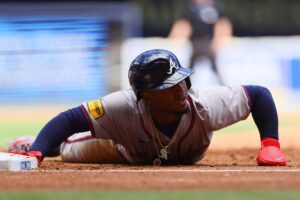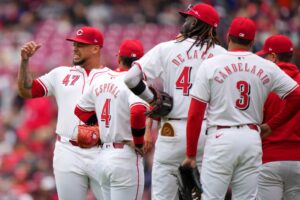The Los Angeles Dodgers franchise began as the Brooklyn Atlantics in 1884. In 1958, the franchise retained its nickname but relocated to Los Angeles, where it continues to thrive today. The franchise has won 11,123 games (.529 W-L), made 35 playoff appearances, won 25 pennants and seven world championships. The team has employed 1,894 position players and 839 pitchers in its history. This article arguably picks the best of the all-time best Dodgers.
The All-Time Dodgers team consists of eight position players, one designated hitter, one starting pitcher, three relievers, one manager, and four honorable mentions.
Let’s go!
Dodgers All-Time Roster
Batters
Catcher – Roy Campanella (1948-1957)
.276/.360/.500; .860 OPS and 123 OPS+; 1,161 H, 242 HR, 856 RBI in 10 seasons as Dodger (entire career)
Hall of Fame (1969); 8x All-Star, 3x NL MVP, 5x World Series
Mike Piazza is second all-time in Dodger career BA at .331 (minimum 2,000 plate appearances; post-Dead-Ball Era) across seven seasons of a 16-year Hall of Fame career. Despite this, Roy Campanella deserves the title of All-Time Dodger catcher. His three NL MVP awards during a tragically-shortened 10-year career are a testament to his value as a player and teammate. That with the likes of Jackie Robinson, Pee Wee Reese, and Duke Snider on the same team, and other all-time greats such as Stan Musial in the same league throughout that entire time. (Jackie Robinson, Don Newcombe, Stan Musial, Willie Mays, and Hank Aaron won NL MVP once during Campanella’s career.)
Roy Campanella’s lifetime batting average was .276, averaged 29 HR per 162 games. These numbers are not as gaudy as Piazza’s .331 and 39 HR per 162 games as a Dodger. But no Dodger, in either Los Angeles or Brooklyn, has won as many MVP awards as Campanella. Campanella is in fourth place in franchise history for home runs. He trails only Duke Snider, Gil Hodges, and Eric Karros. Defensively, Campy was in the Top 10 in NL catcher fielding percentage every year, finishing first twice (1952 and 1957). He was also in the Top 10 in Caught Stealing percentage every year. Campanella’s lifetime average of 57.4% caught stealing is still MLB’s all-time best to this day.
First Base – Gil Hodges (1943, 1947-1961)
.274/.360/.488; .847 OPS and 120 OPS+; 1,884 H, 361 HR, 1,254 RBI in 16 seasons as Dodger (18 years overall)
Hall of Fame (2022); 8x All-Star, 3x Gold Glove 1B, 7x World Series
Although the first baseman for most of his career, Gil Hodges first game was in 1943 when he was 19. However, his baseball career was put on hold during WWII, during which he served in battle, earning a Bronze Star with the US Navy.
Gil Hodges returned to the Dodgers roster as a catcher in June 1947. In 1948, while still a rookie, he was the Dodgers’ catcher on Opening Day – with another rookie named Roy Campanella on the bench. Hodges’ first game at 1B was in June 1948, where he remained a fixture for the Dodgers through 1961. From 1949 through 1959, Hodges averaged 30 HR and 101 RBI for the ‘Boys of Summer.’ After Hodges’ career as a Dodger in 1961, a right-handed batter held the National League record for HR. He was second only to the AL all-time leader, Jimmie Foxx (534). To this day, Hodges is second only to Duke Snider in franchise home runs hit.
Gil Hodges won the NL Gold Glove award ‘only’ three times – perhaps because the award didn’t begin until 1957. He was the NL’s Gold Glove first baseman for each of the first three years of the award.
Second Base – Jackie Robinson (1947-1956)
.313/.410/.477; .887 OPS and 133 OPS+; 1,563 H, 141 HR, 761 RBI in 11 seasons as Dodger (entire career)
Hall of Fame (1962); 6x All-Star, Rookie of the Year, 1x NL MVP, 1x NL Batting Title, 6x World Series
Jackie Robinson has legendary accomplishments both on and off the field and is the only player to have had his number retired by all MLB teams. Robinson broke baseball’s color barrier as a rookie on Opening Day in 1947. Robinson was the Dodgers’ starting first baseman in all but four games. He led the NL with 29 stolen bases and was the first-ever recipient of the Rookie of the Year award. Robinson was the catalyst on six World Series teams for the Dodgers, earning MVP in 1949. Robinson stole home for the first time on June 24, 1947, and would end his career with 19 total steals of home. At the time, that placed him tied with Frankie Frisch for 9th place all time.
Jackie Robinson permanently switched from the first baseman to second baseman at the end of June 1948, when Gil Hodges moved from catcher to first base. Robinson teamed Pee Wee Reese as a second baseman to create a formidable double-play combo. For the remainder of that year and the following four seasons, Robinson led all NL second basemen in double plays turned and finished first or second in NL second base fielding percentage. Robinson ranks third all-time in franchise position player WAR at 61.8.
Third Base – Ron Cey (1971-1982)
.264/.359/.445; .804 OPS and 125 OPS+; 1,378 H, 228 HR, 842 RBI in 12 seasons as Dodger (17 years overall)
6x All-Star, 1x Babe Ruth Award, 1x Lou Gehrig Award, 4x World Series, 1x WS Co-MVP
For about a decade after Jim Gilliam held down the third base position, the Dodgers had a revolving door of players occupying that position for only a year or two – until Ron Cey arrived as a September call-up in 1972. “The Penguin” patrolled third base for the next ten years, starting at least 142 games/year at that position except for the strike-shortened 1981 season. Over that time, he averaged almost 23 HR and 84 RBI per season as the Dodgers made four trips to the World Series. Cey compiled a .963 fielding percentage at third base with the Dodgers, thanks to sure hands and an accurate throwing arm. Cey was Co-MVP of the 1981 World Series, Pedro Guerrero, and Steve Yeager.
Shortstop – Pee Wee Reese (1940-1942, 1946-1958)
.269/.366/.377; .743 OPS and 99 OPS+; 2,170 H, 126 HR, 885 RBI in 16 seasons as Dodger (entire career)
Hall of Fame (1984); 10x All-Star, 1x Lou Gehrig Award, 7x World Series
Maury Wills and Corey Seager were two strong candidates for the All-Time Dodger shortstop, covering the position for 12 years and seven years, respectively. But the nod belongs to 10-time All-Star Pee Wee Reese. Pee Wee demonstrated consistent excellence across a 16-year Hall of Fame career for the Dodgers. Reese was the starting shortstop in each of the 44 World Series games (seven World Series) that the Dodgers played during his career.
Reese compiled 2,170 hits in the regular season and was the Dodger position player leader in overall WAR at 68.5. In 1952, his 30 stolen bases led the NL; he ranked in the Top 10 a total of 12 times. Defensively, Pee Wee was first in NL Defensive WAR four times and in the Top 10 fourteen times during his 16-year career.
Left Field – Zack Wheat (1909-1926)
.317/.367/.452; .819 OPS and 130 OPS+; 2,804 H, 131 HR, 1,210 RBI in 18 seasons as Dodger (19 years overall)
Hall of Fame (1959); 1x NL Batting Champion
Zack Wheat was the most prolific Dodger position player of the pre-integration (pre-1947), Dead-ball (pre-1920) era. But he did play with the Dodgers for seven years of the post-Dead-Ball Era. He finished in the Top 10 for NL batting average nine times, HR eleven times, and RBI eight times. Wheat had the highest fielding percentage for a left fielder two times and was amongst the NL’s top 10 fourteen times.
Zack Wheat’s career numbers still rank high on the all-time Dodgers franchise list. Wheat is still the franchise leader in games played (2,322), at-bats (8,859), and plate appearances (9,731). He is also the franchise leader in hits (2,804), singles (2,038), doubles (46), triples (171), and total bases (4,003). Wheat ranks fourth all-time in franchise position player WAR at 60.0.
Center Field – Duke Snider (1947-1962)
.300/.384/.553; .936 OPS and 142 OPS+; 1,995 H, 389 HR, 1,271 RBI in 16 seasons as Dodger (18 years overall)
Hall of Fame (1980); 8x All-Star, 1x Sporting News Major League Player of the Year, 6x World Series
An 8-time NL All-Star, Duke Snider is the all-time franchise leader in home runs with 389. ‘The Duke of Flatbush’ played in six World Series matchups against the Yankees and White Sox, homering 11 times. Four of those came in 1955 during Brooklyn’s only World Series championship.
Snider led the NL in RBI in 1955 and in-home runs in 1956. He also was a Top 10 finisher in NL batting average five times and in NL home runs, RBI, and total bases nine times each as a Dodger. He is second only to Pee Wee Reese in franchise position player WAR at 65.3.
Right Field – Carl Furillo (1946-1960)
.299/.355/.458; .813 OPS and 112 OPS+; 1,910 H, 192 HR, 1,058 RBI in 15 seasons as Dodger (entire career)
2x All-Star, 1x NL batting champion, 7x World Series with Dodgers
There was close competition for the third outfield spot on the All-Time Dodgers team. Willie Davis and Pedro Guerrero piled up some impressive accomplishments in hits, total bases, offensive, and defensive WAR during their Dodgers. Tommy Davis was a two-time NL batting champion in the early 1960s. Gary Sheffield ranks first overall in career On-Base percentage and slugging average but only played four seasons in Los Angeles. Cody Bellinger has already won NL Rookie of the Year and NL MVP in his brief 5-year career thus far. However, none of these players were primarily right fielders – amongst them, Pedro Guerrero played the most games there – 240 for the Dodgers. Meanwhile, Carl Furillo patrolled right field consistently for 15 seasons, worthy of recognition as the all-time Dodger at that position.
Carl Furillo had a .299 lifetime batting average, and his 1,910 hits and 2,922 total bases place him 7th on the all-time Dodger list in both categories. He won the NL batting title in 1953 with a .344 average and helped his team to the World Series that year – but teammate Roy Campanella won MVP that year. Furillo finished in the Top 5 in NL right fielder fielding percentage for ten straight years (1949-1958). Possessing a powerful and accurate throwing arm, Furillo was in the Top 5 for assists by a right fielder for nine straight years, achieving a high of 23 RF assists in 1951.
Designated Hitter – Manny Mota (1969-1980, 1982)
.315/.374/.391; .765 OPS and 117 OPS+; 605 H, 12 HR, 226 RBI in 13 seasons as Dodger (20 years overall)
1x All-Star, 2x World Series
The National League has used the DH rule in only one season (2020). This category, therefore, allows recognizing one of the most prolific, clutch pinch hitters in history – Manny Mota. Mota amassed an MLB record of 150 pinch hits (.300 BA as PH), surpassing Smoky Burgess in 1979. Mota’s mark has since been eclipsed by Mark Sweeney (175) and Lenny Harris (212). However, Mota remains the record-holder for pinch hits with one team (118). Hall of Fame manager Walter Alston once said of Mota, “As long as I have known him, he hits better as a pinch-hitter than as a regular. He thrives on pressure.” Mota’s .315 lifetime batting average as a Dodger (minimum 2,000 plate appearances) is third on the Dodgers’ all-time list in the post-Dead-Ball Era.
Pitchers
Starting Pitcher – Sandy Koufax (1955-1966)
165-87 W-L (.655), 40 Shutouts, 9 Saves, 2.76 ERA; 2,396 K’s; 2,324 IP, 2.69 FIP, 131 ERA+ in 12 seasons with Dodgers, Hall of Fame (1972), 6x All-Star, 1x NL MVP, 3x NL Cy Young Award, 5x NL ERA title, 3x NL Pitching Triple Crown, 2x Babe Ruth Award, 1x Hutch Award, 4x Sporting News NL Pitcher of the Year, 2x Sporting News MLB Player of the Year, 2x WS MVP, 5x World Series
Sandy Koufax won ‘only’ 165 games during his career, retiring at age 30 due to chronic arthritis in his pitching arm. But for the latter part of his career until his retirement after the 1966 season, Koufax was the most dominant pitcher in baseball history. He won the Cy Young Award in three of his last four seasons. His consistency was on point, averaging a 1.86 ERA with 307 strikeouts during that span. Koufax was the first MLB pitcher to toss four no-hitters. His last no-hitter was a perfect game, the eighth in MLB history.
Koufax pitched in four World Series, helping the Dodgers to victory in three (1959, 1963, 1965). His career World Series ERA was 0.95, which is the lowest for any pitcher in MLB history (40 innings minimum). Koufax was a first-ballot Hall of Fame inductee in 1972, and at age 36, was the youngest player ever to be voted in.
Relievers
Kenley Jansen (2010-Present)
37-26 W-L (.587), 0 Shutouts, 350 Saves, 2.37 ERA; 1,022 K’s; 705 IP, 2.37 FIP, 164 ERA+, 519 Games Finished in 12 seasons, 3x All-Star, 2x NL Reliever of the Year, 2x Sporting News NL Pitcher of the Year, 3x World Series
Kenley Jansen is first overall amongst all Dodger pitchers (starters and relievers) for career games played, saves, games finished, strikeouts per 9 innings (13.1), hits per 9 innings (5.8), WHIP (.928), and Fielding Independent Pitching (2.37). He leads all Dodger relievers in career ERA and WAR. Jansen was the Dodger closer in their 3 World Series appearances thus far in his career.
Eric Gagne (1999-2006)
25-21 W-L (.543), 0 Shutouts, 161 Saves, 3.27 ERA; 629 K’s; 545 IP, 3.40 FIP, 125 ERA+, 212 Games Finished in 8 seasons, 3x All-Star, 1x NL Cy Young Award, 2x NL Reliever of the Year, 1x Sporting News NL Pitcher of the Year
Eric Gagne saved 55 games in 2003, en route to winning the NL Cy Young and NL Reliever of the Year Awards that year. He ranks second to Kenley Jansen in Dodger career saves and strikeouts per 9 innings (10.4). He is third amongst all Dodger relievers in hits per 9 innings (7.0). Gagne also holds the record of 84 consecutive saves converted (Zach Britton is second at 60). He converted an impressive 161 of 167 save opportunities throughout his career with the Dodgers.
Jim Brewer (1964-1975)
61-51 W-L (.545), 1 Shutout, 126 Saves, 2.62 ERA; 672 K’s; 822 IP, 2.94 FIP, 127 ERA+, 302 Games Finished in 12 seasons,
1x All-Star, 2x World Series
Jim Brewer is fifth on the all-time Dodgers saves list and second only to Kenley Jansen amongst Dodger relievers in games played (474), games finished (302), and in hits per 9 innings (6.9). His Dodger ERA of 2.62 is the third lowest in franchise history amongst relief pitchers. (Jeff Shaw and Todd Worrell rank third and fourth in franchise history for saves with 129 and 127, respectively. However, they did not play for the Dodgers for the requisite five seasons for all-time consideration.)
Manager
Tommy Lasorda (1976-1996 with Dodgers)
1599-1439 W-L (.526); 4x All-Star teams, 4 NL pennants, 2 WS championships in 21 seasons,
Hall of Fame (1997); 2x NL Manager of the Year
Tommy Lasorda is one of four Dodger managers who are in Cooperstown. Wilbert Robinson, Walter Alston, Leo Durocher are the other three. During their tenures, Alston and Lasorda demonstrated the most extraordinary longevity and team success, though radically different in their style and management approach. When Danny Ozark left the Dodgers’ third-base coaching box to manage the Phillies, Lasorda became Alston’s third-base coach. Tommy would remain there for four seasons, becoming Dodger manager upon Alston’s retirement in 1976. For the 43 seasons between 1954 and 1996, the Dodgers’ bench bosses were only Alston and Lasorda.
The Dodgers won seven NL pennants and four World Series championships under Alston. However, the Dodgers won four NL pennants and two Fall Classics with Lasorda under the helm. Compared to Lasorda’s two-time selection, Alston never won NL Manager of the Year. But the award was not given out until 1983, Lasorda’s 8th season as Dodger manager – long after Alston had retired. Although very close, statistically, Alston’s teams had better numbers than Lasorda’s. Both managers had their proponents and critics amongst players. But the nod is nevertheless given to Tommy Lasorda as All-Time Dodger manager because of the undying enthusiasm and motivation he brought to the team — and baseball.
Honorable Mentions: Clayton Kershaw, Mike Piazza, Wes Parker, Vin Scully
The honorable mention features many Hall of Famers and future one too. Clayton Kershaw is a three-time NL Cy Young Award winner with five ERA titles. Mike Piazza batted .331 lifetime as a Dodger and would have been a strong contender for all-time catcher had he played more than seven seasons with the team. First baseman Wes Parker is the only player named to the All-Time Gold Glove Team in 2007 that is not in the Hall of Fame. Finally, Vin Scully never played for the team, but as Dodger broadcaster for 67 years, he is generally regarded as one of the greatest Dodgers of all time.
Click here for the All-Time Tournament Team Headquarters page.
Main Image
Players/Managers Mentioned: Roy Campanella, Gil Hodges, Jackie Robinson, Ron Cey, Pee Wee Reese, Zack Wheat, Duke Snider, Carl Furillo, Manny Mota, Sandy Koufax, Kenley Jansen, Eric Gagne, Jim Brewer, Tommy Lasorda, Clayton Kershaw, Mike Piazza, Wes Parker, Vin Scully, Mike Marshall, Kirk Gibson, Gary Sheffield, Stan Musial, Willie Mays, Hank Aaron, Eric Karros, Jimmie Foxx, Frankie Frisch, Jim Gilliam, Pedro Guerrero, Steve Yeager, Maury Wills, Corey Seager, Willie Davis, Cody Bellinger, Mark Sweeney, Lenny Harris, Smoky Burgess, Jeff Shaw, Todd Worrell, Wilbert Robinson, Walter Alston, Leo Durocher, Danny Ozark






